pissed off feminist fights back: cheap vices

**Trigger Warning: Discussion of suicide**
Earlier this month, Vice, known for their gratuitous photo shoots and “daring” content, published a spread entitled “Last Words” in which models posed as literary heroines. Seems fairly innocuous, right? Except that they were literary heroines in the moments prior to their suicides, accompanied by a description of their deaths and an itemised list of the models’ outfits.
The women they chose struggled with all manner of mental illnesses. Take, for instance, Virginia Woolf, who in 1941 put stones in her coat pockets and walked into the River Ouse to drown herself. She had suffered from bouts of extreme depression and was later thought to have grappled with bipolar disorder. The other writers featured were Dorothy Parker (who only attempted suicide), Charlotte Perkins Gilman, Sylvia Plath, Iris Chang, Sanmao and Elise Cowen. Sanmao’s itemised list even included the stockings she used to hang herself.
What the spread seems to do is glamourise mental illness — and even suicide — in order to sell clothes. Neither of these things are glamorous. With a little bit of research, the editors might have found that sufferers struggle on a daily basis; that it just isn’t fashionable.
Within hours of being posted, the spread was slammed across the international media, with a model coming out to speak about her feelings while doing the shoot. Vice later apologised and took it down from their website. Their apology was weak at best, focusing not on the issues at hand, but rather on the “artful” nature of the photographs and Vice‘s unconventional approach. The spread remains in print, in their Fiction Issue (which was devoted to female writers, contributors, photographers, illustrators, and painters; a great idea). This spread and the uproar is not the fine line between provocative and bad taste. This is the big fat line between provocative and trivialising suicide for profit.
That’s not to say that these women don’t deserve to be revered. Plath is possibly the most popular person on Tumblr right now. Woolf’s writing is at times evocative and incisive and even daring, exploring the world through a feminine lens. But instead, these women aren’t being glorified for their literary prowess, but for their tragic deaths. These were women who were part of the fantasy of the “tortured writer”, people with friends and family and careers (and in the case of Chang, who died in 2004, still have grieving loved ones), who in moments of desperation, fear, loneliness decided to end their lives. But we shouldn’t encourage this, treat it as an enviable trait, say it makes a good story. The tortured writer is just that, tortured, and we shouldn’t seek to emulate that, whether in fashion shoots or in everyday life.
Studies have even shown that if a report mentions the method of suicide, the occurrence of copycats rises. Helen Lewis from the guardian writes about the implications of this: ‘Every year in England and Wales, about 24,000 young people between the age of 10 and 19 attempt suicide. What will children in that kind of distress see when they look at those Vice pictures? They will see a menu. Using famous women makes it worse, because vulnerable people can fixate on a favorite writer and identify with them.’
On Jezebel, Jenna Sauers wrote: ‘These weren’t fictional characters; these were real women, who lived and struggled and died, and to treat their lowest moments as fodder for a silly fashion spread is shameful and sad.’
While thinking about this story, I was reminded of a visit to the Golden Gate Bridge in San Francisco. A plaque attached read: ‘The consequences of jumping from this bridge are fatal and tragic.’
It’s that tragedy, and the emotions and often mental illness that leads to it, that Vice failed to consider or even address in their apology.

